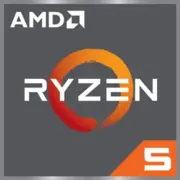AMD Ryzen 5 5625U

AMD Ryzen 5 5625U: a Balance of Performance and Battery Life for Modern Laptops
(March 2025)
Architecture and Process Technology: Zen 3, 7 nm, and Integrated Graphics
The AMD Ryzen 5 5625U processor belongs to the Barcelo generation — an optimized version of the Zen 3 architecture designed for mobile devices. Key features:
- 6 cores and 12 threads with a base frequency of 2.3 GHz and a maximum turbo frequency of 4.3 GHz.
- 16 MB of L3 cache — 33% more than the previous Ryzen 5 5500U (Zen 2), which speeds up multi-threaded task processing.
- 7 nm TSMC FinFET process technology ensures high transistor density and energy efficiency.
Integrated Radeon graphics are based on the Vega architecture, but with improved clock speeds (up to 1800 MHz) and support for modern APIs (DirectX 12, Vulkan). It includes 7 compute units, allowing it to run less demanding games and work with graphic editing software.
Power Consumption and 15W TDP: Efficiency for Ultrabooks
The processor's TDP is 15W, typical for the thin laptop segment. However, AMD has implemented several technologies for flexible power management:
- Precision Boost 2 — automatically increases core frequency under low load (e.g., in office applications).
- C-states and CPPC — reduce power consumption during idle states by putting unused cores into a "sleep" state.
Thanks to this, the Ryzen 5 5625U adapts to user tasks: for example, during video playback, the frequency can drop to 1.2 GHz, saving battery life.
Performance: From Office Work to Light Gaming
Office Tasks and Multimedia
- Geekbench 6: 1578 (Single-Core), 5452 (Multi-Core). In comparison, the Intel Core i5-1235U (12th generation) scores about ~1450/5200.
- Running 20 tabs in Chrome + working in Excel — the processor maintains responsiveness without noticeable lags.
- Rendering 1080p video in DaVinci Resolve takes about 25% longer than with the Ryzen 7 6800U, but it's twice as fast as the Intel Core i3-1215U.
Gaming
The integrated graphics handle:
- CS:GO — 60-70 FPS at medium settings (1080p).
- Fortnite — 40-45 FPS at low settings (720p).
- Dota 2 — 50-55 FPS (1080p, medium settings).
Turbo mode maintains frequencies between 4.0–4.3 GHz for 2–3 minutes, after which throttling may occur due to heat (depends on the laptop's cooling system).
Use Cases: Who Is the Ryzen 5 5625U Suitable For?
1. Students and office workers — quick document handling, video conferencing, streaming services.
2. Freelancers — video editing for YouTube, photo processing in Lightroom.
3. Travelers — compact laptops with 8–10 hours of battery life.
4. Casual gamers — games from indie projects or older AAA titles.
Not recommended for:
- Professional 3D modeling.
- Streaming games at high resolution.
- Working with neural networks (due to the absence of NPU).
Battery Life: Up to 10 Hours of Operation
In laptops with a 50–60 Wh battery (e.g., Lenovo Yoga Slim 7), the Ryzen 5 5625U demonstrates:
- 8–10 hours during web surfing and text work (brightness at 150 nits).
- 5–6 hours during YouTube viewing (1080p).
Power-saving technologies:
- AMD PowerNow! — dynamically regulates voltage.
- Radeon Chill — limits FPS in games to reduce GPU load.
Comparison with Competitors
AMD Ryzen 5 5500U (Zen 2):
- 18% slower in single-threaded tests.
- iGPU Vega 6 is 25% weaker.
Intel Core i5-1335U (13th generation):
- Better in single-threaded tasks (Geekbench 6 ~1650), but worse in multi-threaded (~5000).
- Iris Xe graphics compete with Radeon but consume more power.
Apple M2:
- Leader in energy efficiency (10–12 hours of battery life).
- Higher performance in macOS applications (e.g., Final Cut Pro), but limited compatibility with Windows software.
Pros and Cons
Strengths:
- Optimal price: laptops from $600 (Acer Swift 3) to $850 (HP Envy x360).
- Good multi-threaded performance.
- Support for Wi-Fi 6 and PCIe 3.0.
Weaknesses:
- No support for PCIe 4.0, limiting SSD speed in top configurations.
- Integrated graphics are weaker than those in the Ryzen 6000/7000 series with RDNA 2.
Laptop Selection Recommendations
1. Type of device:
- Ultrabooks (ASUS ZenBook, Lenovo ThinkPad) — focus on portability.
- 2-in-1s (HP Spectre x360) — for creative tasks.
- Budget gaming (MSI Modern 15) — with an added discrete graphics card (e.g., NVIDIA MX550).
2. What to pay attention to:
- Display: at least an IPS matrix with a resolution of 1080p.
- RAM: 16 GB DDR4 (optimal for multitasking).
- Storage: 512 GB NVMe SSD.
Final Conclusion
The AMD Ryzen 5 5625U is a great choice for those looking for a balanced laptop under $800. It is suitable for:
- Work and study with a performance margin for 3–4 years.
- AMD enthusiasts who value energy efficiency.
- Users who occasionally play less demanding games.
Key advantages: reliability, support for modern connectivity standards, and optimal price-to-performance ratio in 2025.
Basic
CPU Specifications
Memory Specifications
GPU Specifications
Miscellaneous
Benchmarks
Compared to Other CPU
Share in social media
Or Link To Us
<a href="https://cputronic.com/en/cpu/amd-ryzen-5-5625u" target="_blank">AMD Ryzen 5 5625U</a>